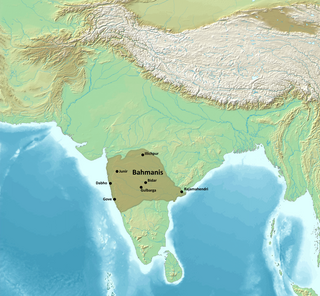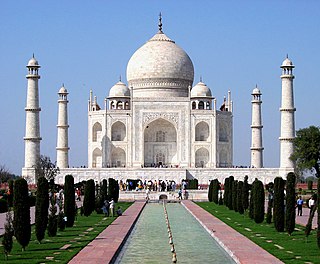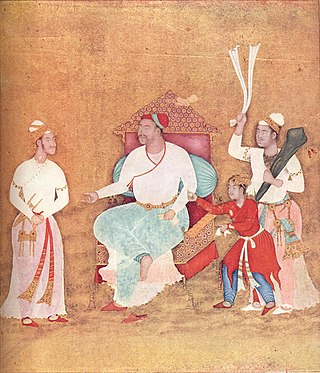Aftermath

The Delhi Sultanate continued to decline and the Bahmani Sultanate would begin its rise to power as the first Muslim state centered in the Deccan, its capital was established at Kalaburagi. [9] [10] [11]
| Ismail Mukh's rebellion against the Delhi sultanate | |||||||||
|---|---|---|---|---|---|---|---|---|---|
| Part of Decline of the Tughlaq dynasty | |||||||||
| |||||||||
| Belligerents | |||||||||
| Bahmani Sultanate Deccani Amirs | Delhi Sultanate | ||||||||
| Commanders and leaders | |||||||||
| Ismail Mukh Afghan Ala-ud-Din Bahman Shah Malik Yal Afghan | Muhammad bin Tughluq Nizam-ud-din (POW) Imad-ul-Mulk † Malik Jauhar Burhan-ud-din Bilgrami Aziz Himar † | ||||||||
| Strength | |||||||||
| 15,000 [2] 15,000 reinforcements [2] 5,000 from Ismail Mukh [2] Total: 35,000 | 30,000 [2] | ||||||||
| Casualties and losses | |||||||||
| Unknown | Unknown, believed to be heavy [2] | ||||||||
The rebellion of Ismail Mukh took place between 1346 and 1347 when Deccani Amirs placed Ismail Mukh, also known as Nasir-ud-din Ismail Shah, an Afghan noble, at the head of a rebellion centered at Daulatabad. The rebellion saw the decline and loss of the Delhi Sultanate's control over the Deccan, which had been a part of the Delhi Sultanate since the Khilji dynasty. Ismail Mukh abdicated in favor of Zafar Khan, on 3 August 1347, [3] [4] which saw the establishment of the Bahmani Sultanate, which existed from 1347 to 1527.
In 1346, a low-born named Aziz Himar was appointed governor over the cities of Daulatabad, Malwa, and Dhar. [5] Azim Himar was instructed on using intrigue and spying on the centurions of Daulatabad and other nearby cities, as rebellion was common to spark in the Deccan. Following this, a rebellion was triggered in Gujarat, Vadodara, and Bahroch. As a result, Aziz Himar set out to quell the rebellions, but was defeated and killed by the rebels. [6] Realizing the situation, Muhammad bin Tughlaq, the emperor of the Delhi Sultanate, marched against the rebels himself and defeated them, pacifying the region. [7] Following this, Muhammad sent two nobles to Daulatabad, and wished for the centurions to meet him. Fearing the worst, the Daulatabad centurions killed the nobles who had arrived at Daulatabad. Alongside this, they imprisoned Mawlānā Nizam-ud-din, and killed many other officers of the Delhi Sultanate, officially declaring rebellion. [7]
Following this, the rebels opened the imperial treasury in Daulatabad and divided its spoils amongst themselves. And after further being reinforced from centurions that came from Gujarat, they placed an Afghan noble, Ismail Mukh, also known as Nasir-ud-din as the leader of this rebellion. [7] With this, Muhammad departed from Bahroch and marched on Daulatabad. The rebels met Muhammad in battle, but were defeated. As a result, the rebels fled to the citadel of Daulatabad, holding out for siege there, while other officers such as Zafar Khan departed for their own lands. [7] Muhammad besieged the citadel and allowed the city of Daulatabad to be plundered, while also dispatching Imad-ul-Mulk against Zafar Khan. The siege of Daulatabad's citadel continued for three months until another rebellion was triggered in Gujarat, which demanded the attention of Muhammad. Muhammad marched with all the populace of Daulatabad to Gujarat to quell the rebellion, leaving Malik Jauhar, Burhan-ud-din Bilgrami, and other nobles to continue the siege of the citadel. [7]
Despite this, they were unable to halt the dauntless pursuits of the imperial army led by the rebels. After Muhammad withdrew, the centurions that were dispersed now re-assembled their forces under Zafar Khan and defeated Imad-ul-Mulk in battle, killing him. [7] The rebel forces under Zafar Khan then marched on Daulatabad and defeated the besieging army, completely routing them. [8]
Following the victories of Zafar Khan, Ismail Mukh deemed Zafar Khan as a worthy ruler and capable successor. [2] Ismail Mukh used the excuse of his old age and abdicated in favor of Zafar Khan. The Deccani Amirs followed in Ismail Mukh's decision and crowned Zafar Khan on 3 August 1347. [1] [3] [9]
With this, Zafar Khan established the Bahmani Sultanate, taking on the title of Alauddin Bahman Shah, and successfully made the Deccan an independent Muslim state from the Delhi Sultanate. [1]

The Delhi Sultanate continued to decline and the Bahmani Sultanate would begin its rise to power as the first Muslim state centered in the Deccan, its capital was established at Kalaburagi. [9] [10] [11]

Muslim period in the Indian subcontinent is conventionally said to have started in 712, after the conquest of Sindh and Multan by the Umayyad Caliphate under the military command of Muhammad ibn al-Qasim. It began in the Indian subcontinent in the course of a gradual conquest. The perfunctory rule by the Ghaznavids in Punjab was followed by Ghurids, and Sultan Muhammad of Ghor is generally credited with laying the foundation of Muslim rule in Northern India.
The Deccan sultanates were five late-medieval Indian kingdoms—on the Deccan Plateau between the Krishna River and the Vindhya Range—that were created from the disintegration of the Bahamani Sultanate and ruled by Muslim dynasties: namely Ahmadnagar, Berar, Bidar, Bijapur, and Golconda. The sultanates had become independent during the break-up of the Bahmani Sultanate. The five sultanates owed their existence to the declaration of independence of Ahmadnagar in 1490, followed by Bijapur and Berar in the same year. Golconda became independent in 1518, and Bidar in 1528.

The Bahmani Sultanate was a late medieval Muslim empire that ruled the Deccan Plateau in India. The Bahmani Sultanate came to power in 1347 during the rebellion of Ismail Mukh against Muhammad bin Tughlaq, the Sultan of the Tughlaq dynasty of Delhi. Ismail Mukh then abdicated in favour of Zafar Khan, who would establish the Bahmani Sultanate.

Indo-Persian culture refers to a cultural synthesis present on the Indian subcontinent. It is characterised by the absorption or integration of Persian aspects into the various cultures of modern-day republics of Bangladesh, India, and Pakistan. The earliest introduction of Persian influence and culture to the subcontinent was by various Muslim Turko-Persian rulers, such as the 11th-century Sultan Mahmud Ghaznavi, rapidly pushed for the heavy Persianization of conquered territories in northwestern Indian subcontinent, where Islamic influence was also firmly established. This socio-cultural synthesis arose steadily through the Delhi Sultanate from the 13th to 16th centuries, and the Mughal Empire from then onwards until the 19th century. Various Indo-Muslim dynasties of Turkic, local Indian and Afghan origin patronized the Persian language and contributed to the development of a Persian culture in India. The Delhi Sultanate developed their own cultural and political identity which built upon Persian and Indic languages, literature and arts, which formed the basis of an Indo-Muslim civilization.

Muhammad bin Tughluq, also named Jauna Khan as Crown Prince, also known by his epithets, The Eccentric Prince, or The Mad Sultan, or The Wisest Fool was the eighteenth Sultan of Delhi. He reigned from February 1325 until his death in 1351. The sultan was the eldest son of Ghiyath al-Din Tughluq, founder of the Tughlaq dynasty. In 1321, the young Muhammad was sent by his father to the Deccan Plateau to fight a military campaign against the Kakatiya dynasty. In 1323, the future sultan successfully laid siege upon the Kakatiya capital in Warangal. This victory over King Prataparudra ended the Kakatiya dynasty.
Mahmud Begada or Mahmud Shah I was the most prominent Sultan of the Gujarat Sultanate. Raised to the throne at young age, he successfully captured Pavagadh and Junagadh forts in battles which gave him his name Begada. He established Champaner as the capital.

The Gujarat Sultanate or Sultanate of Guzerat was a late medieval Indian kingdom in Western India, primarily in the present-day state of Gujarat. The kingdom was established in 1394 when Muzaffar Shah I, the Governor of Gujarat, declared independence from the Tughlaq dynasty of Delhi.

Ahmad Shah I, born Ahmad Khan, was a ruler of the Muzaffarid dynasty, who reigned over the Gujarat Sultanate from 1411 until his death in 1442. He was the grandson of Sultan Muzaffar Shah, founder of the dynasty.
The Farooqi dynasty or the Farooq Shahi was the ruling dynasty of the Khandesh Sultanate from its inception in 1382 till its annexation by the Mughal emperor Akbar in 1601. The founder of the dynasty, Malik Ahmad participated in a rebellion against the Bahmani ruler Muhmmad Shah I in his early years. When he was compelled to flee from Deccan, he established in Thalner on the Tapti River. After receiving the grant of the fiefdoms of Thalner and Karanda from Firuz Shah Tughluq in 1370, he conquered the region around Thalner, which later became known as Khandesh. By 1382, he started ruling independently.
Zafar Khan may refer to:

Ala-ud-Din Hasan Bahman Shah whose original name was Zafar Khan or Hasan Gangu, was the founder of the Bahmani Sultanate.

Taj ud-Din Firoz Shah, also known as Firoz Shah Bahmani, was the ruler of the Bahmani Sultanate from 16 November 1397 to 22 September 1422. Firuz Shah is considered an important ruler of the Bahamani Sultanate. He expanded his kingdom and even succeeded in conquering the Raichur Doab from Vijaynagara kingdoms.

The Deccanis or Deccani people are an Indo-Aryan ethno-religious community of Deccani-speaking Muslims who inhabit or are from the Deccan region of Western and Southern India. The community traces its origins to the shifting of the Delhi Sultanate's capital from Delhi to Daulatabad in 1327 during the reign of Muhammad bin Tughluq. Further ancestry can also be traced from immigrant Muslims referred to as Afaqis, also known as Pardesis who came from Central Asia, Iraq and Iran and had settled in the Deccan region during the Bahmani Sultanate (1347). The migration of Muslim Hindavi-speaking people to the Deccan and intermarriage with the local Hindus whom converted to Islam, led to the creation of a new community of Hindustani-speaking Muslims, known as the Deccani, who would come to play an important role in the politics of the Deccan. Their language, Deccani, emerged as a language of linguistic prestige and culture during the Bahmani Sultanate, further evolving in the Deccan Sultanates.
Mahmood Shah or Shihab-Ud-Din Mahmud was the sultan of the Bahmani Sultanate from 1482 until his death in 1518. His long rule is noted for the disintegration of the sultanate and the creation of the independent Deccan sultanates.

Muzaffar Shah I, born Zafar Khan, was the founder of the Muzaffarid dynasty in Medieval India, reigning over the Gujarat Sultanate from 1391 to 1403 and again from 1404 to 1411. The Kumbalgarh inscription says that Kshetra Singh defeated and captured Zafar Khan, King of Patan and the Khan remain in imprisonment with other Rajas.
Deval Devi was the daughter of Karan Deva II. She was married to Khizr Khan, the eldest son of Alauddin Khalji, in 1308. Eight years later, Khizr Khan was executed by his brother Qutb ud din Mubarak Shah, and Deval was taken into the latter's harem. In 1320, Mubarak in turn was stabbed and beheaded by his supposed favourite, Khusro Khan, and his followers. Deval was then married to Khusro Khan. Her story, of being passed from hand to hand amongst a series of ambitious, power-hungry Muslim men is the basis of the celebrated Gujarati historical novel Karan Ghelo authored by Nandshankar Mehta.
Gujarat, a region in western India, fell under the Delhi Sultanate following repeated expeditions under Alauddin Khalji around the end of the 13th century. He ended the rule of Vaghela dynasty under Karna II and established Muslim rule in Gujarat. Soon the Tughluq dynasty came to power in Delhi whose emperor carried out expeditions to quell rebellion in Gujarat and established their firm control over the region by the end of the century. Following Timur's invasion of Delhi, the Delhi Sultanate weakened considerably so that the last Tughluq governor Zafar Khan declared himself independent in 1407 and formally established the Gujarat Sultanate.
Abdul Malik Isami (1311–?) was a 14th-century Indian historian and court poet. He wrote in Persian language, under the patronage of Ala-ud-Din Bahman Shah, the founder of the Bahmani Sultanate. He is best known for Futuh-us-Salatin, a poetic history of the Muslim conquest of India.